I am a member of the baby boomer generation where TV has been a steady presence since Day 1. Thousands of black and white images must have flickered across my retina in the early sixties, imparting who knows what subliminal messages to my impressionable mind. In 1961 speech, Newton Minnow, the Federal Communications Commissioner, memorably characterized TV as a “vast wasteland,” consisting of game shows, Westerns, and unrealistic family dramas. But I just loved the wasteland. And then in 1964, the feminist Betty Friedan weighed in with an article in TV Guide, titled “TV and the Feminine Mystique, in which she stated that TV represented the American woman as “stupid, unattractive and insecure, silently suffering through the stifling life of a full time homemaker.” Friedan was referring to domestic dramas such as “Leave it to Beaver,” 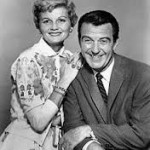 “Fathers Knows Best,” or the “Adventures of Ozzie and Harriet” where the dutiful wife bustles around doing drudgy domestic chores, waiting for the moment when the husband returns from some nameless job, flings open the door and says, “Hi Honey, I’m home!”
“Fathers Knows Best,” or the “Adventures of Ozzie and Harriet” where the dutiful wife bustles around doing drudgy domestic chores, waiting for the moment when the husband returns from some nameless job, flings open the door and says, “Hi Honey, I’m home!”
Now I certainly wasn’t aware of the swirling social issues and the burgeoning women’s movement, but looking back on it, I think that Betty Friedan’s message might have resonated with me. After all, it’s right there in my 1958 yearbook, which asked first graders what we all wanted to be when we grew up. My response was a very tepid, “I guess I’ll be a mother,” as if sadly accepting my expected fate and reluctantly foregoing any consideration of alternative careers. I was already getting the sense that my bright and energetic mother was straining at the tight confinement of a housewife. My mother loved to write song ditties for birthdays and other celebrations, and I remember her singing one of her verses over the phone to one of her friends,
“How does all that priceless precious knowledge that I learned at Vassar college
Help me to cope with sinks full of spit and grit”
And then she continued on with the chorus line, which repeated “sinks with spit and grit” multiple times. Although she was laughing, I felt the dispiriting element of truth in her serenade.
Even though I routinely succumbed to the vast wasteland, I do think that the appeal of one of my favorite shows – the Avengers – was its enlightened view of women. The Avengers, a British show that made it to the US in 1965, was a light-hearted spoof of the James Bond spy genre, and featured John Steed and Emma Peel as the operatives. The Emma character, played by Diana Rigg, was specifically designed to attract male viewers. In fact, 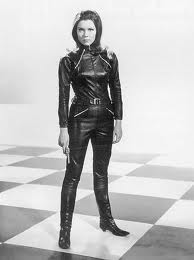 during development, the writers referred to her as M. Appeal, where the “M” stood for man. Her clothing was a big part of the attraction, featuring black leather catsuits, seguing to brightly colored clingy jumpsuits, dubbed Emmapeelers. The 1960s reviews freely referred to her entire persona as “kinky,” a word that had not yet acquired its deviant sexual connotations, but merely described Emma as a fresh, young, boundary pusher.
during development, the writers referred to her as M. Appeal, where the “M” stood for man. Her clothing was a big part of the attraction, featuring black leather catsuits, seguing to brightly colored clingy jumpsuits, dubbed Emmapeelers. The 1960s reviews freely referred to her entire persona as “kinky,” a word that had not yet acquired its deviant sexual connotations, but merely described Emma as a fresh, young, boundary pusher.
The big surprise for the network was that women loved Emma; the story line emerged that while men wanted Emma Peel, woman wanted to be Emma Peel. She was a bright, independent woman with a witty sense of humor, unflappable even in near death moments. In one episode she cheerfully submits to waterboarding, and then is thrown into a museum of medieval torture equipment, chained to the wall in a chastity belt. But it was all in good fun, contrasting with the truly creepy realism of present day Law and Order, where a quirky medieval museum would be transformed into a fetid sewer with rats, and the chastity belt would morph into some sort of horrible mutilation with a wooden soup spoon. But then of course Emma Peel was never a victim. She wrangles her way out of the chastity belt by tipping over the neighboring suit of armor, grabs the spear and uses it to get the keys. She then dispatches the incoming gang of burly villagers with a few quick karate chops here and there.
Even as a naïve teenager, I clearly knew that Emma Peel was sexy, but she was beautiful without being va-va-va-voom. I loved her undyed and uncrimped hairdo; her basic brown hair fell softly to her shoulders. Occasionally she would run her fingers through her hair 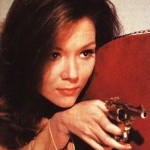 and toss it back, a far cry from the other TV moms (and my mother) who went to the beauty parlor for a lacquered perm. Let’s face it, I knew that I was never going to be any kind of Emma Peel, nor would I ever wear “kinky” catsuits, but all the same, Emma’s look was aspirational, compared to say, Marilyn Monroe, or the Bond girls, whose look was all about sexual conquest. Emma Peel’s predecessor on the show was a character named Cathy Gale, played by an Honor Blackman, who left the show to play Pussy Galore in “Goldfinger.” I hope that she got paid handsomely to subject herself to such a demeaning and dreadful double entendre name, which James Bond always pronounced as a purring “Po-o-o-h-s-y. Like Emma, Pussy was an expert in martial arts, and there is fight
and toss it back, a far cry from the other TV moms (and my mother) who went to the beauty parlor for a lacquered perm. Let’s face it, I knew that I was never going to be any kind of Emma Peel, nor would I ever wear “kinky” catsuits, but all the same, Emma’s look was aspirational, compared to say, Marilyn Monroe, or the Bond girls, whose look was all about sexual conquest. Emma Peel’s predecessor on the show was a character named Cathy Gale, played by an Honor Blackman, who left the show to play Pussy Galore in “Goldfinger.” I hope that she got paid handsomely to subject herself to such a demeaning and dreadful double entendre name, which James Bond always pronounced as a purring “Po-o-o-h-s-y. Like Emma, Pussy was an expert in martial arts, and there is fight 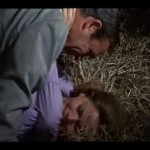 scene in a horse barn where she and Bond take turns flipping each other into piles of hay. But the fight quickly transforms into energetic foreplay and Pussy finally succumbs when Bond pins her down on a scratchy hay bale.
scene in a horse barn where she and Bond take turns flipping each other into piles of hay. But the fight quickly transforms into energetic foreplay and Pussy finally succumbs when Bond pins her down on a scratchy hay bale.
In contrast, Emma Peel had an refreshing relationship with her dapper partner John Steed. A sexual context could hardly be ignored – one of Diana Rigg’s great attributes was her looks, but the part was written to be sexually ambiguous. First of all, there was very little physician contact between the two of them, at most Mrs. Peel might straighten the carnation in Steed’s lapel. Sure there was a very witty repartée between Steed and Peel, but it seemed more like friendly teasing than a sexual jousting match. Imagine the spectrum of male/female relationships, with a loving relationship between two siblings at one end, and at the other is Marilyn Monroe poured 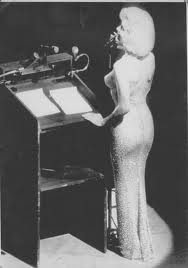 into a skin tight barely-there sequined dress singing a breathless Happy Birthday to JFK. Well, Emma Peel and John Steed would find themselves in the elusive (but sought after) middle ground, friends of opposite sexes whose relationship is not defined by the man or woman’s spouse, true and equal friends with no other agenda than enjoying each other’s company.
into a skin tight barely-there sequined dress singing a breathless Happy Birthday to JFK. Well, Emma Peel and John Steed would find themselves in the elusive (but sought after) middle ground, friends of opposite sexes whose relationship is not defined by the man or woman’s spouse, true and equal friends with no other agenda than enjoying each other’s company.
The character of Emma Peel was not perfect. First of all, while Steed was a professional, Emma was described as “talented amateur.” Apparently, the show’s developers, presumably all men, were not liberated enough to let Emma be a professional with a paying job. Also, I didn’t care for her status as a “widow.” Her husband was supposedly a test pilot who died in a plane crash, and maybe the show’s writers thought single women should still be living with their parents. A widow, on the other hand, was “experienced” and could manage living alone. When Diana Rigg decided to leave the show after three years, she was written out in a very disappointing fashion. Her dead husband reemerges from the depths of the Amazonian jungle, and Emma decides to give up the spy business for married life. Well I guess that’s better than being killed off.
Ironically, Diana Rigg followed in the footsteps of her predecessor Honor Blackman when she became a Bond girl in the 1969 movie, “On Her Majesty’s Secret Service,” starring George Lazenby as James Bond. Perhaps both women hoped to get a career boost from a Bond movie, but the role is a step backward in terms of women’s liberation. Diana Rigg plays Tracy, an incredibly spoiled and troubled international socialite, and Tracy’s father offers to give Bond some key information about the arch villain Blofeld, but only if he promises to marry his wayward daughter. Gone is the care free hairstyle and “kinky” banter of her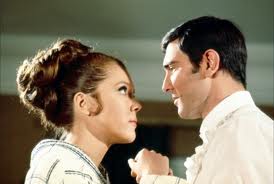 Avenger days – replaced by a theatrical “up do” and traditional high society clothing. Like most Bond movies, Tracy’s dialog was very scant, and most of her scenes with Bond consist of chase scenes amid a hail of bullets. Tracy and Bone do get married at the end, but in the last scene one of the bullets finally finds its mark; Tracy gets shot in the head in a drive by shooting and dies in Bond’s arms.
Avenger days – replaced by a theatrical “up do” and traditional high society clothing. Like most Bond movies, Tracy’s dialog was very scant, and most of her scenes with Bond consist of chase scenes amid a hail of bullets. Tracy and Bone do get married at the end, but in the last scene one of the bullets finally finds its mark; Tracy gets shot in the head in a drive by shooting and dies in Bond’s arms.
Once she departed the Avengers, Diana Rigg and I went our separate ways, me to college and medical school, and Diana returned to her theatrical roots and enjoyed a storied career as a Shakespearean stage actress, receiving the honorary title of “Dame of the Empire” in 1996. Some 30 years later Nick and I were in London and I spotted Diana Rigg in the play, “Mother Courage.” I knew nothing about the play, but both Nick and I were excited to see the fabulous Mrs. Peel in the flesh. Of course the tiny problem was that I had fixed the 30 year old Diana Rigg in my mind, and thus was totally unprepared for the 60 year old woman who now played a grandmother! When Diana and I first crossed paths in the 1960s, I considered ourselves in roughly the same demographic, me as a teenager, and her a role model 14 years my senior. Now thirty years later, I felt that we had totally diverged. I considered myself, perhaps delusionally, still youngish. In contrast, during our hiatus Diana had traversed from 35 to 65 and was no longer an aspirational mentor, but a cautionary tale. Mother Courage was a worn out peasant woman who was just defeated by life, and Diana hobbled around the stage using a cane. It was a very depressing anti-war play in which all three of her children died. I yearned for the care free years when Mrs. Peel and I were young and spirited with a rosy future stretching out in front of us.
The next time I saw Diana Rigg was in the 2006 movie the Painted Veil. Her name was in small print in the credits, so I knew that she didn’t have a starring role, but off I went. By now I had caught up to Diana Rigg. I was an empty nester in my late 50s, the bulk of my 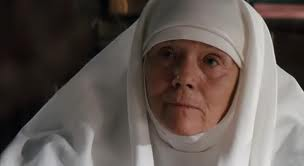 career behind me and I was open to role models to guide my third third. And there she was at the very end of the movie, playing an elderly nun, the epitome of graceful aging, with a wise and all knowing smile, proudly displaying her hard-earned but kindly wrinkles. We’re back on the same page again.
career behind me and I was open to role models to guide my third third. And there she was at the very end of the movie, playing an elderly nun, the epitome of graceful aging, with a wise and all knowing smile, proudly displaying her hard-earned but kindly wrinkles. We’re back on the same page again.
The missing words in the following poem are anagrams, i.e. words that share the same letters like post, stop, and spot. The number of asterisks indicates the number of letters. Your job is to solve the missing words based on the above rules and the context of the poem. Scroll down for answers.
For women in the 1960’s, TV was a wasteland that was vast,
But Emma Peel brought a ray of hope the moment she was ****.
Sure she was sexy and wore the kind of suits that **** wear well,
But she’s a natural beauty, not like a Marilyn va-va-voom bombshell
Emma’s witty and smart and **** with confidence to avenge misdeeds
And best of all, she’s a full and equal partner to the very dapper John Steed
Follow Liza Blue on:
Share:
